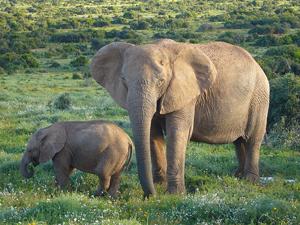Australian scientist proposes importing elephants, rhinos to combat wildfires
African elephants, like this one in Addo National Park in South Africa, could be imported to Australia to eat a grass believed to be feeding a rash of wildfires. (Photo by Gorgo, via Wikimedia Commons.)
Australia’s Northern Territory is a vast region that has experienced an unusually high number of wildfires in recent years.
One cause is an exotic grass that is a major fuel for fires. Global warming may be one as well.
Now, an Australian scientist is proposing a controversial solution: importing elephants and rhinoceroses to eat the plant, known as gamba grass.
Gamba grass was imported from Africa in the 1930s. Scientists brought it to Australia for cattle farmers because it produced more feed for livestock than native grasses. Over the decades, gamba grass has spread across a large portion of Australia’s Northern Territory.
“Now it’s become very rampant, and it’s producing tremendously intense fires,” said David Bowman, an environmental scientist at the University of Tasmania.
Bowman is the author of a new commentary in the journal Nature, in which he proposes bringing elephants and rhinoceroses to Australia to eat the grass.
“I’m thinking of using a big animal as an ecological machine to otherwise control something for which we don’t have any other options,” Bowman said.
When gamba grass matures, it becomes tall and woody and is no longer edible for cattle or native species, like kangaroos. Elephants and rhinos, on the other hand, love the grass. Bowman thinks they would slow down the spread of the grass.
The idea may make sense on some level, but Bowman’s colleagues aren’t welcoming it.
“It’s not a solution at all,” said Stephen Garnett, a conservation biologist at Australia’s Charles Darwin University.
He said Australia is already overrun by a range of exotic species, including camels and water buffaloes. The country is spending millions of dollars trying to cull the feral animals.
Garnett said Bowman’s idea is a bit like the children’s song “There Was an Old Lady Who Swallowed a Fly.” The woman swallows a spider to eat the fly, then swallows a bird to eat the spider, and so on, each time creating an even bigger problem than the one she sought to solve.
“And the last verse is that she swallowed a horse, and then she died, of course,” Garnett said. “David’s idea is a bit like swallowing a rhinoceros. It’d be yet another feral animal on Australian land.”
Bowman said he’s not proposing that elephants and rhinos be allowed to run wild.
“If we’re going to use these things, we’d use them in a sophisticated way,” Bowman said. He suggested sterilizing the animals, tracking them with GPS collars and containing them with fences.
Bowman said he expected resistance to his idea, but he insists something must be done to reduce Australia’s wildfire risk. If scientists don’t want elephants and rhinos, he hopes he has at least provoked them to come up with other creative solutions.
